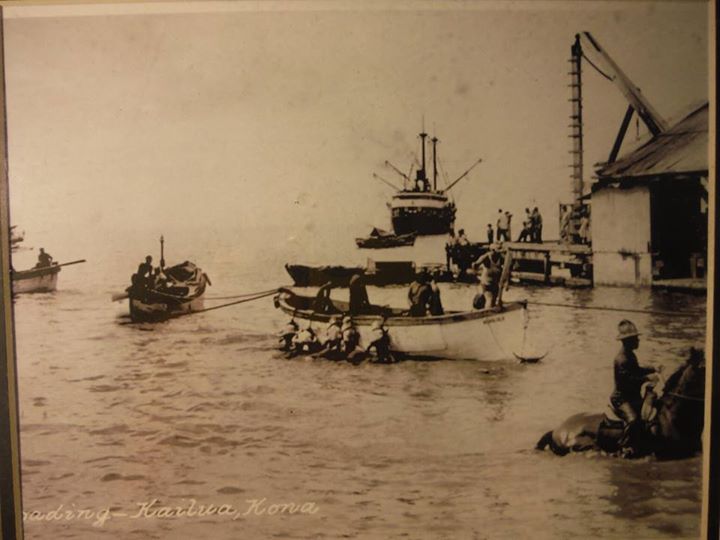Monkeypod (Pukui refers to it as ‘ōhai) was introduced to Hawai‘i in 1847 by Peter A Brinsmade, then consul from the Kingdom of Hawai‘i at Mexico City, who brought in two seeds.
One became a tree which was at Bishop and Hotel Streets in downtown Honolulu until 1899, when it was cut down to permit construction of a building. The other seed was planted at Kōloa, Kauaʻi, and produced a tree that was the parent of a large stand of monkeypod there. (CTAHR)
Originally from northern South America, primarily Venezuela, it goes by many names in the countries to which it has been introduced. In most English-speaking countries it is called rain tree.
A January 23, 1902 article in the Hawaiian Star notes, “Monkey Pod Valuable. Marston Campbell Shows Finely Polished Sample of the Wood.”
“Assistant Superintendent of Public Works Marston Campbell has had a section of native wood polished for exhibition to the government. The slab Is taken from the upper trunk of a monkey pod and shows a beautifully polished light wood not unlike mahogany, heavy and close grained.”
“‘This is what the people of Honolulu are burning in their stoves,’ said Mr. Campbell ‘The calabashes from the wood are splendid and I have some tables of It that cannot be beaten for polish and appearance.’”
“‘The wood is of great commercial value and there is plenty of It around.’ One tree furnishes enough material for a whole set of furniture. It is very hard and takes a splendid polish. He had to give up trying to surface it by hand and used the buffer at the planing mill for satisfactory results.”
“Wray Taylor has these notes in his agricultural report for 1900 ‘Albizzia Saman – Monkey pod – grows freely in lower portion of Tantalus forest though not to such size as In town.’ It would seem that line the algeroba, the monkey, pod nourishes best on sea level and not higher than 500-feet.”
Here, it’s typically planted for shade. In some places, the pods are feed for cattle, hogs, and goats. Some people chew the pods for the sweetish flavor like licorice.
Hawaiʻi has had a couple notable Monkeypod trees.
First, in 1866, Samuel Clemens (Mark Twain) traveled through Hawaii writing articles for the Sacramento Union, which were the basis for several chapters in Roughing It.
Twain spent four months in the islands in 1866, when he was 31 and working on becoming famous. Waiʻōhinu boasts of a monkeypod tree which was planted by Twain, when he visited there.
It stood in the front yard of the residence of Samuel Kauhane, former chairman of the Hawaii supervisors, and is an excellent specimen of the tree.
It is known as the “Mark Twain” tree. (Honolulu Star-Bulletin, November 22, 1915) In 1957, the original tree was blown down and a new tree grew from its sprouts that still stands today.
Moanalua Gardens is also the home of a large monkeypod tree (about 130-years old) that is known in Japan as the Hitachi Tree, one of the most recognizable corporate icons in Japan.
The Hitachi Tree first originated through a TV commercial for Japanese electronics manufacturer Hitachi, Ltd that first aired in Japan in 1973.
The tree is widely recognized, especially in Japan, and has become an important symbol of the Hitachi Group’s reliability, and earth-friendliness. It also enhances Hitachi’s brand value as a visual representation of its corporate slogan: “Inspire the Next.”
Over the past 40 years, the Hitachi Tree has become a valuable Hitachi Group asset as a familiar and respected image in Hitachi’s expanding messages globally.
An earlier agreement between the Damon Estate and Hitachi gave Hitachi exclusive worldwide rights to use the tree’s image for promotional purposes in exchange for annual payments. It was reported that Hitachi Ltd, has agreed to pay the owner of the Moanalua Gardens $400,000 a year for 10 years to use the garden’s famous monkeypod tree in its advertising.
The tree is registered as an exceptional tree by the City and County of Honolulu and cannot be removed or destroyed without city council approval.
We also know monkeypod for the various bowls, figures and furniture and other woodworking art/function. I suspect, like many, I have a ‘project’ monkeypod end table that needs refinishing.








































